But as an adult who now lives in a walkable city and hasn’t owned a car in years, I’ve realized it’s about time we start calling out cities that aren’t pedestrian-friendly. To bring attention to this issue, Tennessee residentJon Jon Wesolowski, also known asThe Happy Urbanist, recently shared a TikTok showing just how impractical and unpleasant the walk to his local park is. Below, you’ll find all of the details, as well as conversations with Jon Jon, city planner and international advocate for more walkable cities,Jeff Speck, and research fellow atProject Drawdown, Cameron Roberts, PhD.
The majority of American cities were not designed to be pedestrian-friendly

Image credits:Brett Sayles / Pexels (not the actual photo)
To emphasize this issue, Jon Jon Wesolowski took viewers along to see just how dangerous and impractical the walk to his local pool is
“Despite living a walkable distance to a public pool, I want to show you how street and urban design makes this unwalkable. Right off the bat, this section of the walk has almost no urban tree canopy, which can change the surface temperature up to 25 degrees.”
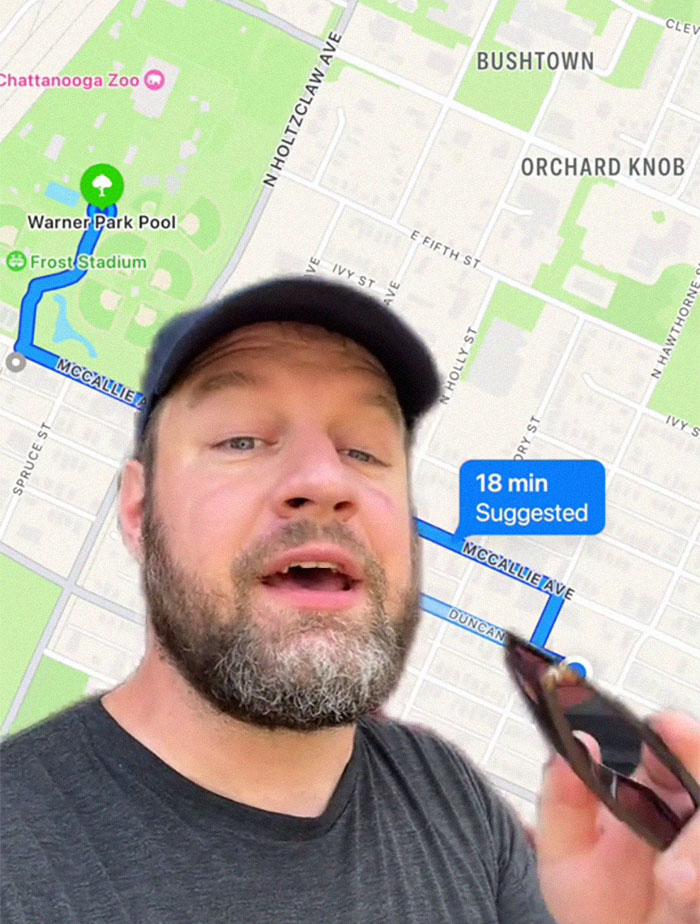
Image credits:jonjon.mp4
“My neighbor Matt often posts his pictures of the difference in temperature based on the shade and not shade in his yard. Here’s the most recent one he posted.”
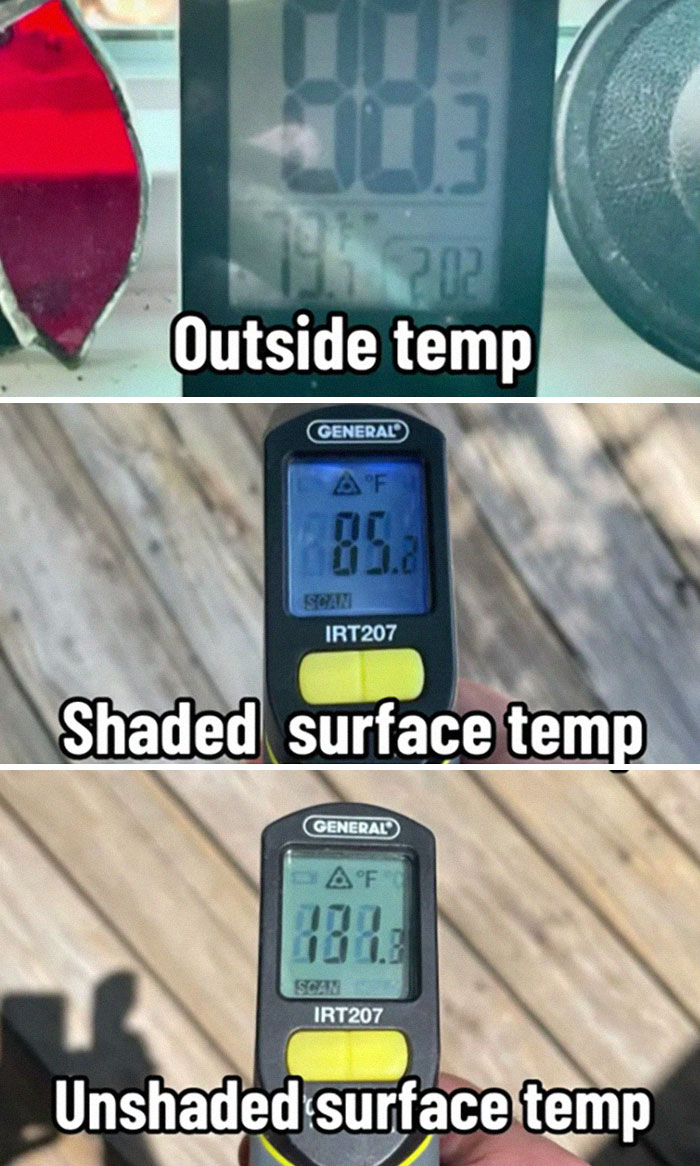
“It’s illegal to park within 15 feet of an intersection, in part because this car decreases visibility from pedestrians that are entering the intersection.”
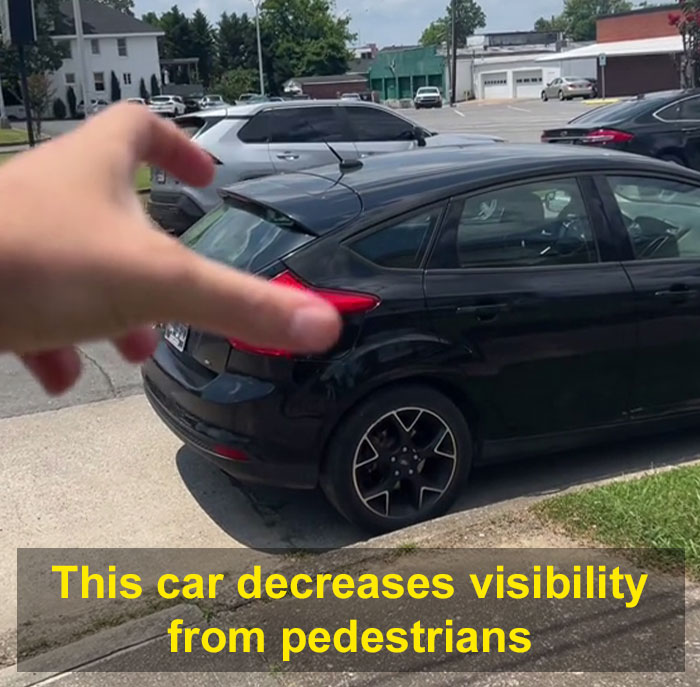
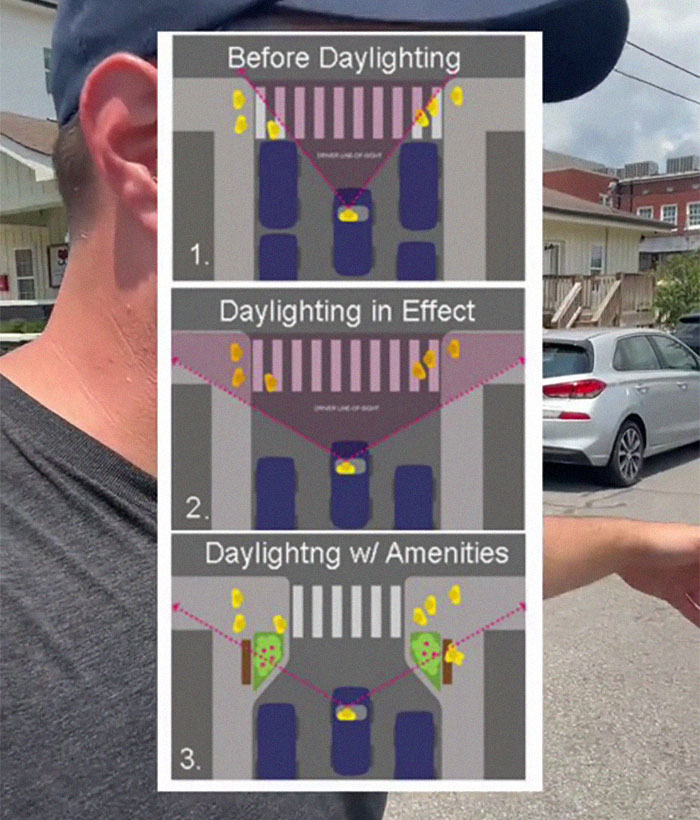

About a third of Americans don’t have access to a park within a 10-minute walk from home
“According to the Trust for Public Land, over 100 million Americans are not within walking distance of a park.”
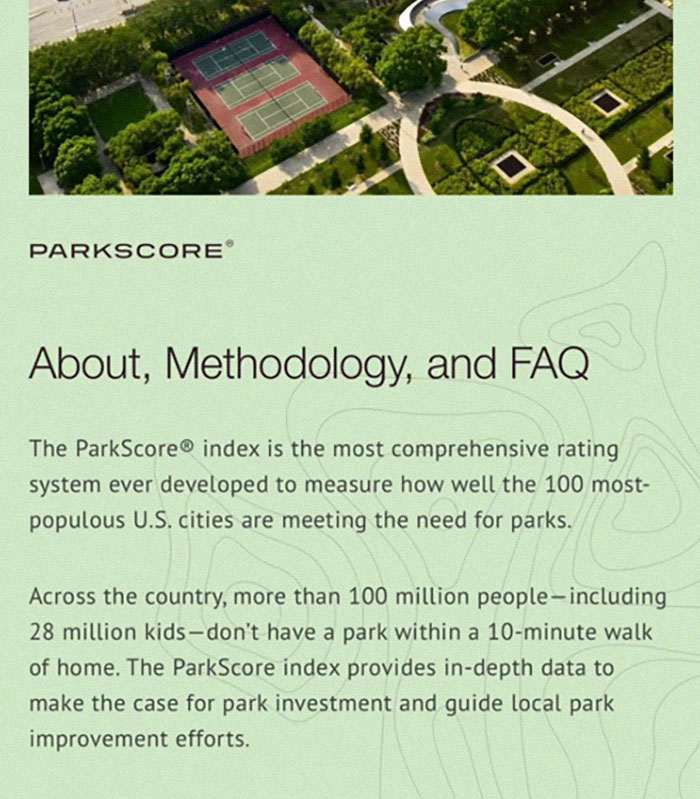
“But despite this being a walkable distance, there’s many reasons why it’s unwalkable. This road is incredibly unsafe. With it being four lanes and a sidewalk bumped right up against the road, it’s exposing pedestrians to really fast traffic.”
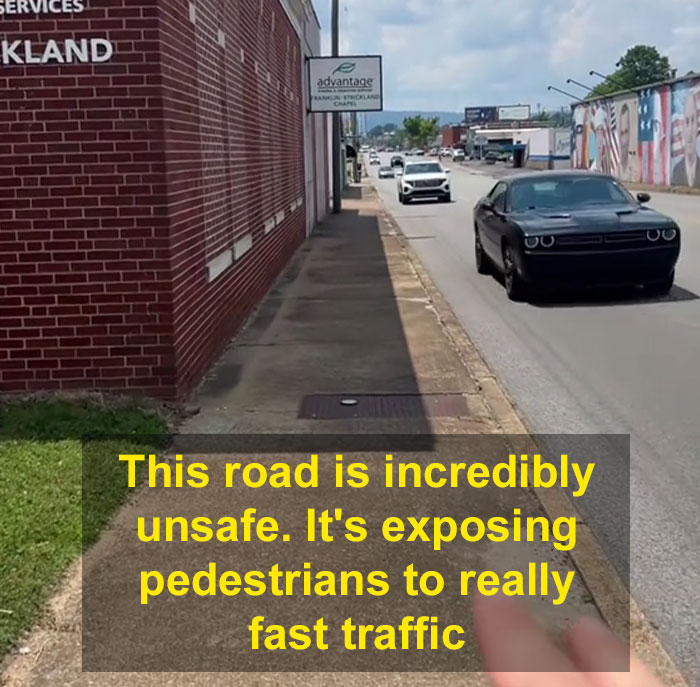
“I want you to notice something. Things like light poles are offset.”
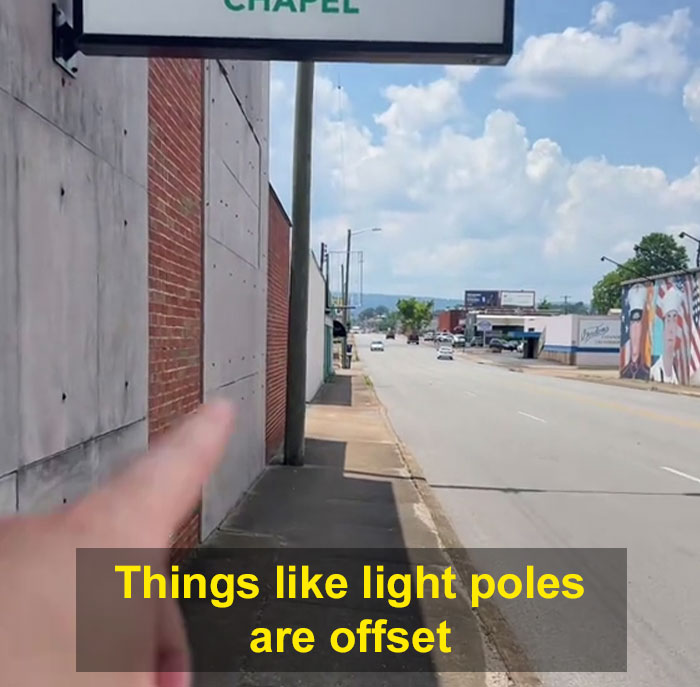
“Clearing obstacles away from cars is what is known as a clear zone.”
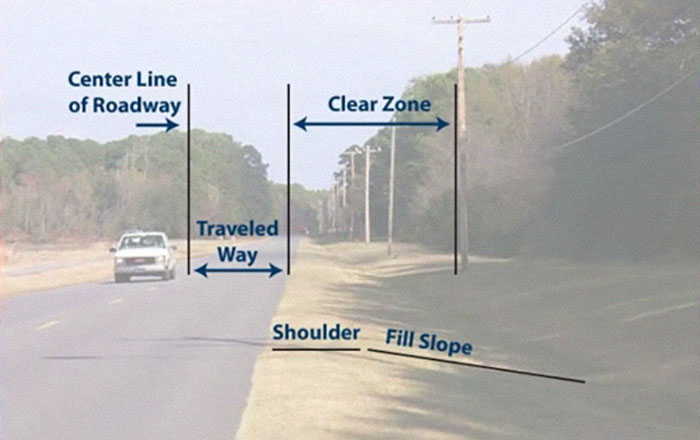
“Essentially, it gives cars a little space to recover if they go off track before they damage or hit anything. But the irony of this is that humans inhabit the clear zone.
And just a reminder, people do have to walk here.”
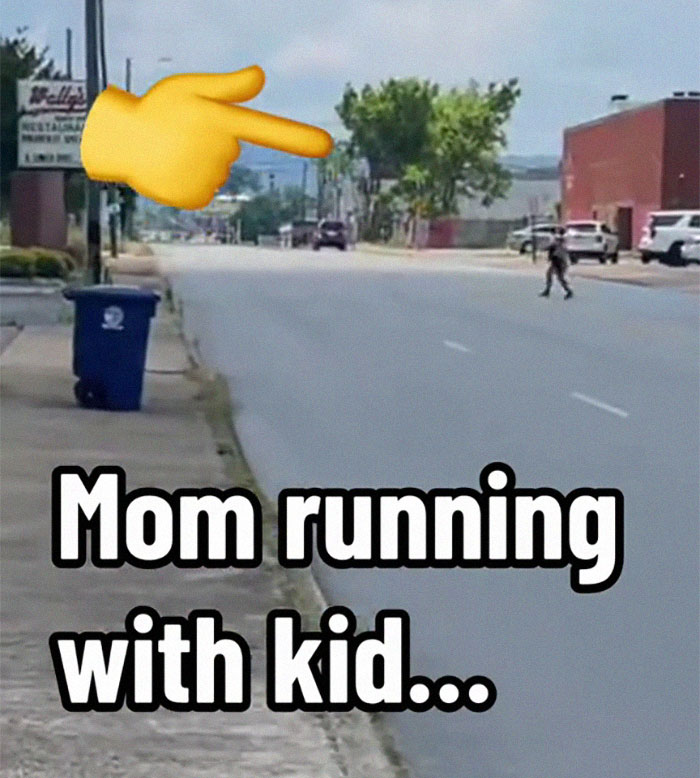
“Not a lot of curb cuts, which makes it a challenge for accessibility.”
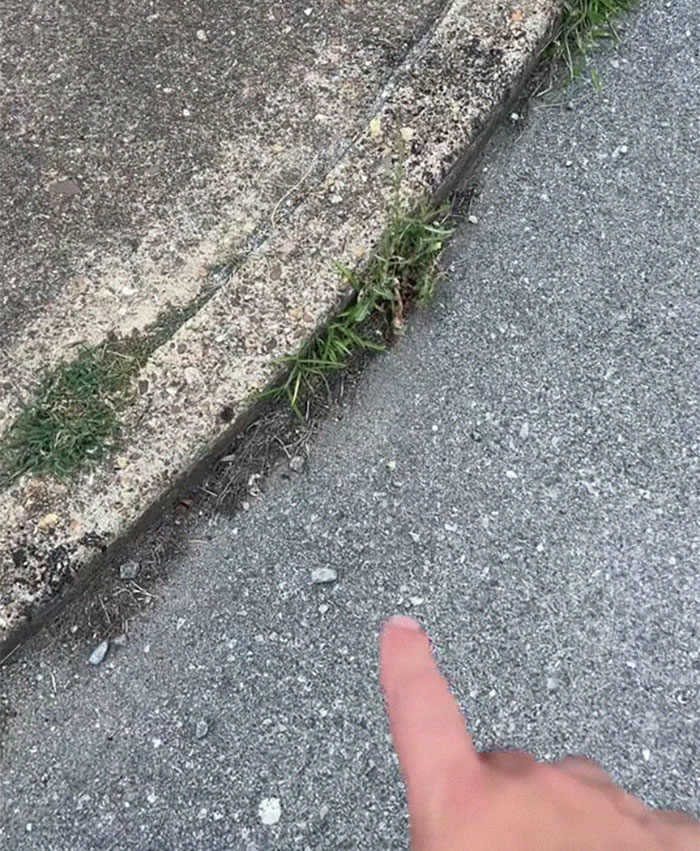
“Mind you, jaywalking is not illegal in Tennessee. You can do it. In fact, that is an unofficial unmarked walk. Pedestrians technically have right of way and vehicles should stop, but they don’t. I guarantee you if that mother and child I showed you earlier got hit crossing the street, then the first paragraph of the news article would mention that she was not in a crosswalk.
What would you expect her to do? To walk half a mile that way to the next lit intersection and then walk a half mile back with a small toddler?”

Jon Jon pointed out a variety of reasons why his walk was unpleasant and unsafe
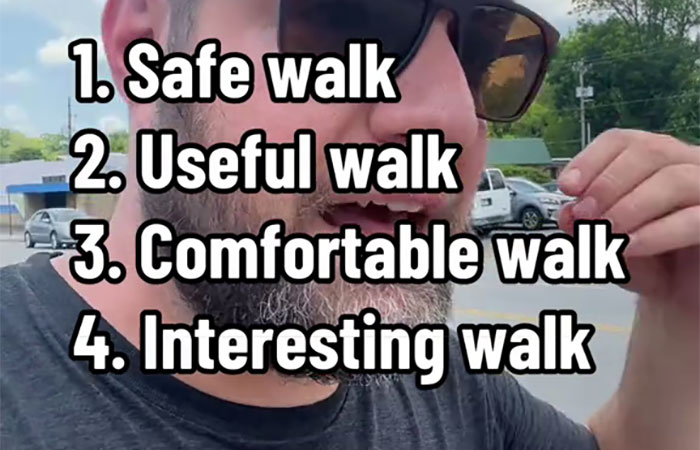
“A while ago, this used to be four lanes in one direction.”
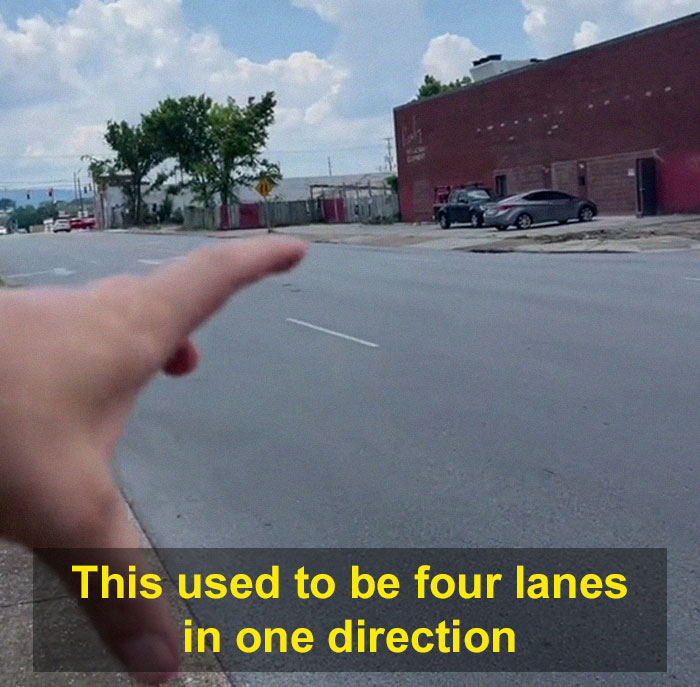
“Pay attention to this building, because it’s in the background of this picture.”
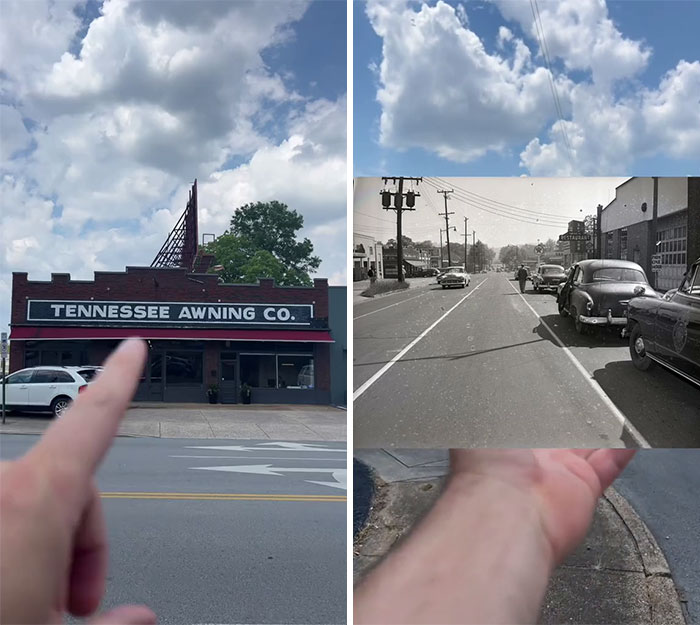
“And you can see when this road was narrower and slower, it was lively. But when we made it four lanes in one direction, it made this neighborhood a place to pass through rather than a destination in which to arrive at. So now what you’ll see is a lot of vacant land, parking lot. Though they switched it back to two lanes in each direction, which helped, it’s still too wide and doesn’t facilitate any other type of traffic like bikes and whatnot. Even if this was a safe walk, it’s not really a practical walk. There’s not a lot of places for me to go to to meet my daily needs via walking. There’s considerations like the comfortable walk, the enjoyable walk, which again with the lack of urban canopy, the speeding cars and noise, the general lack of ambiance, this is not a very enjoyable walk.
Notice the bollards, the reinforced wall, and the guardrail right here on the sidewalk.”
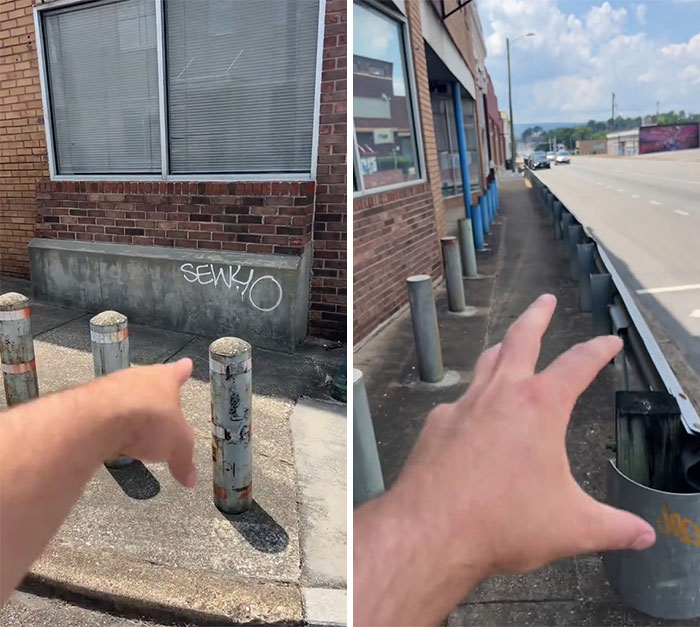
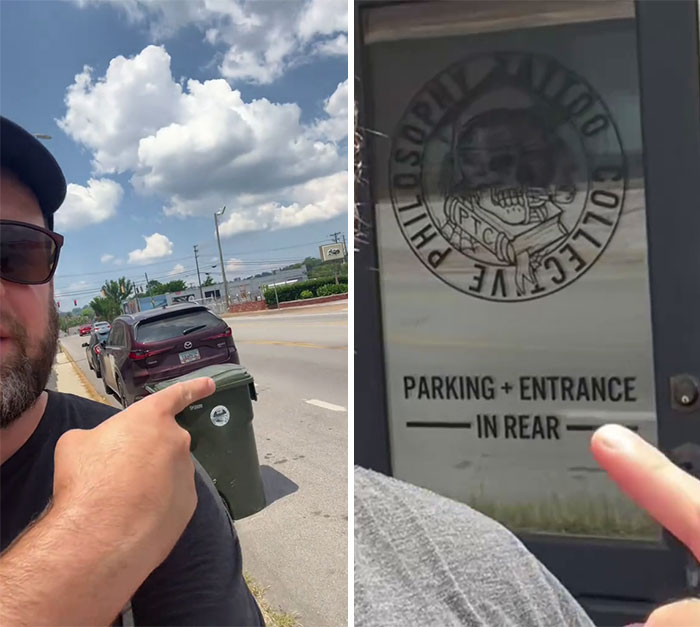
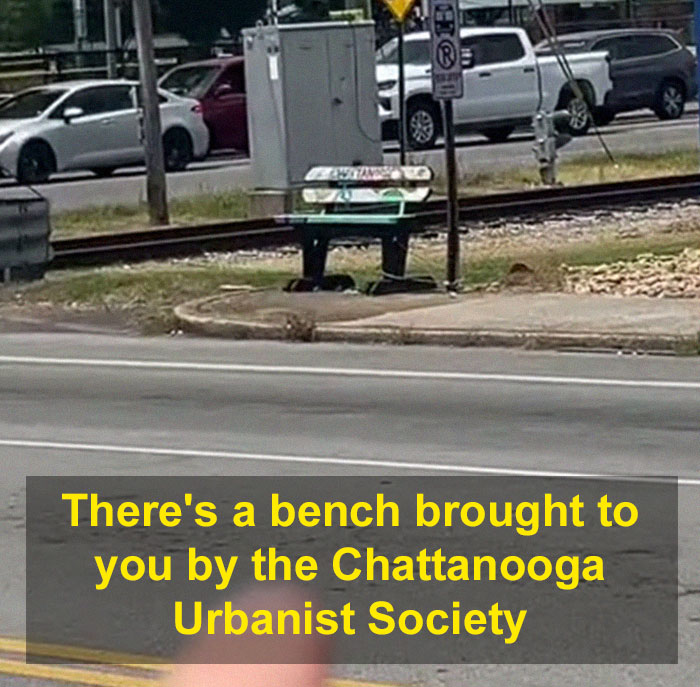
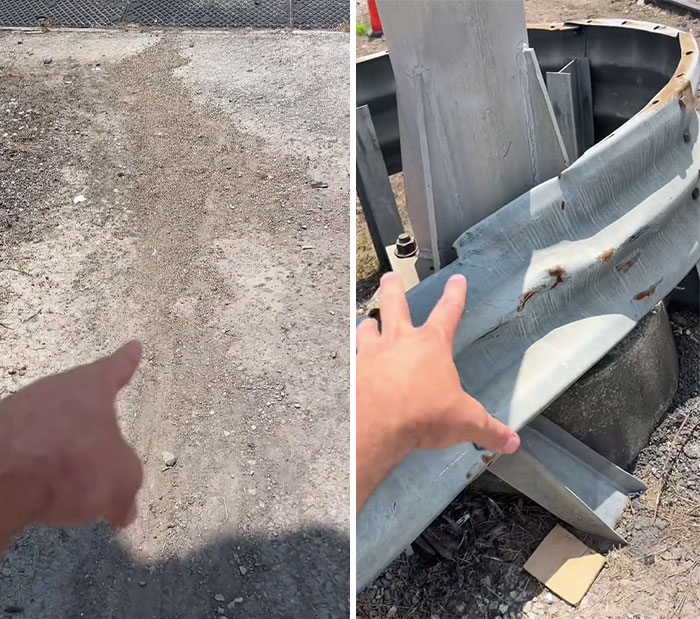
“And now the walk sign is telling me I can cross here, but notice how the sidewalk abruptly ends, I have no option to continue on.”
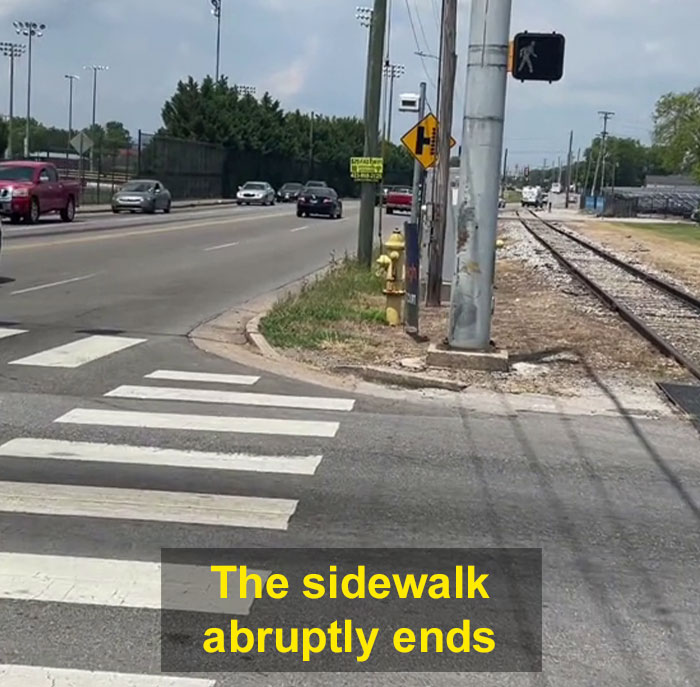
“More damage in a pedestrian space. Lots of shattered car pieces in detritus.”
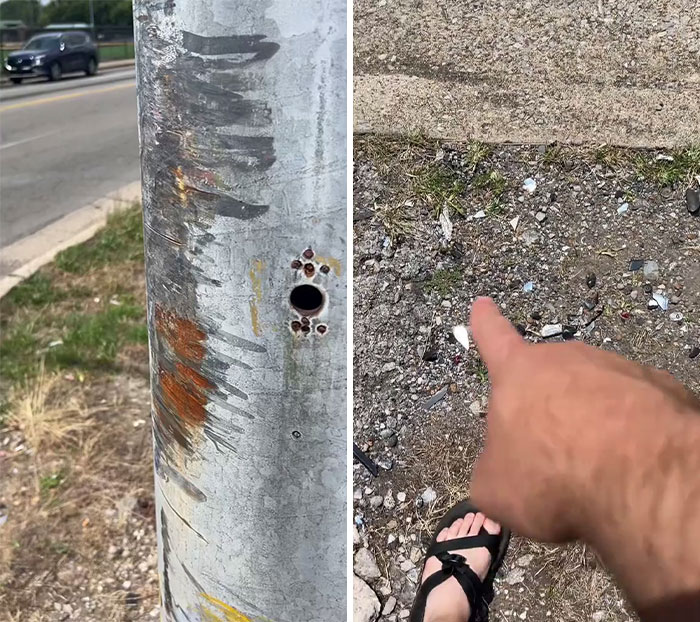
“More highway infrastructure and ballards on this side of the building. That’s because it was four lanes in this direction.”
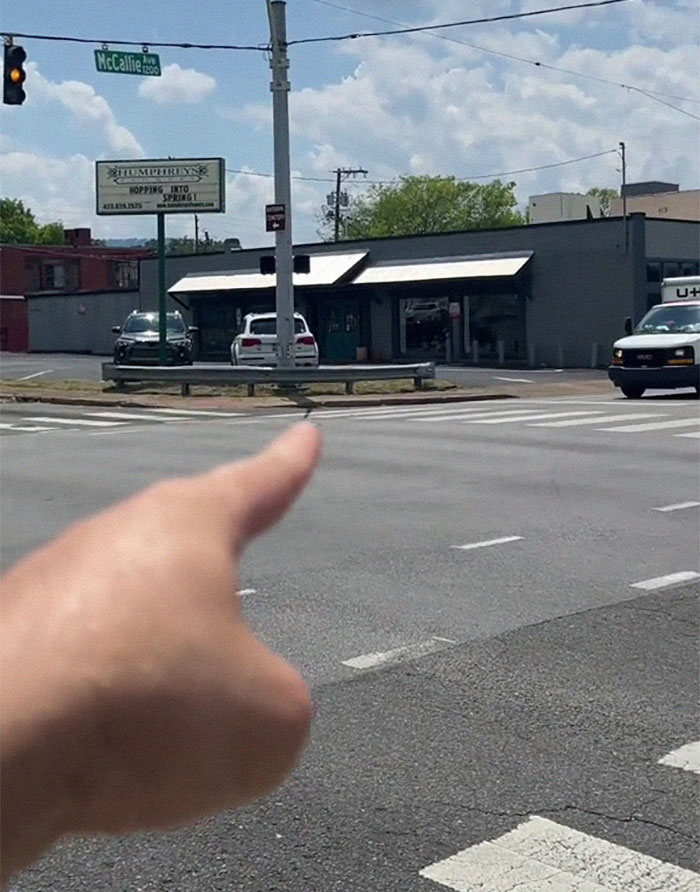
“I’m technically at the park I want to be at, but notice there’s a high fence keeping me from going in and it’s even higher [at places] like 15 feet.”
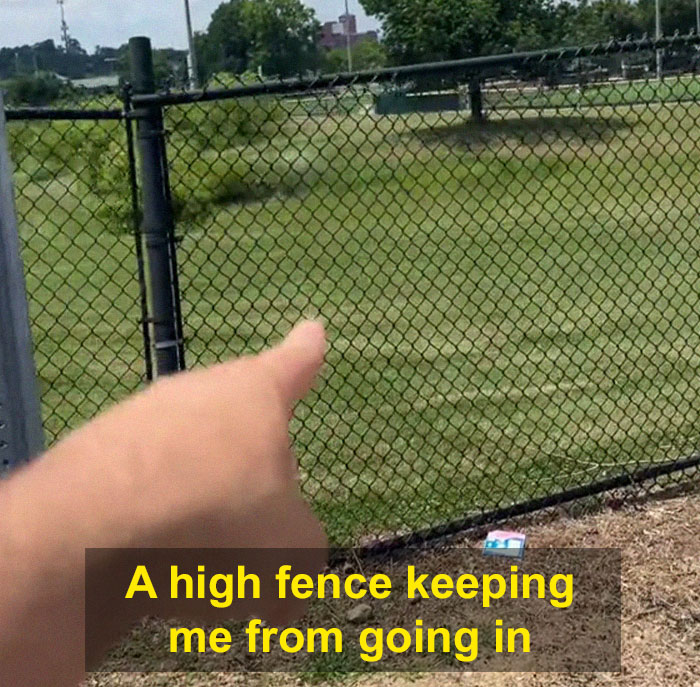
“This is something most park departments don’t even take into consideration. Because regardless of which direction I go as a pedestrian, I’m technically almost walking past where I’m going and then walking back to it. I can get to this park in just over 10 to 12 minutes, but it’s another 6 to 7 minutes to get to the pool. And notice how the signs offset. That’s to minimize the potential damage when cars come here.”
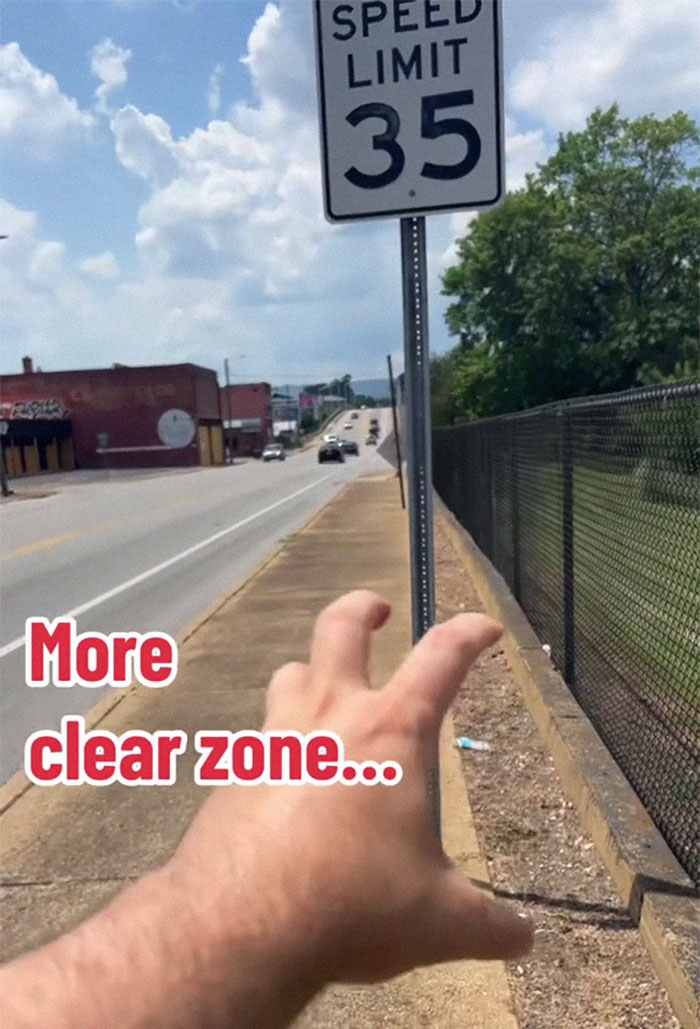

“But if you look up there, you can see some signs that are completely covering the sidewalk.”

“For months, there were barrels that were used in the street removed to the sidewalk and left on the sidewalk completely obstructing it because again, they don’t expect that pedestrians or people would be here on foot.
The brick doesn’t match because a car ran into this and destroyed it.”

“This is a slip lane. It prioritizes a car being able to not have to slow down to turn in, but it’s also the continuation of the pedestrian path.”
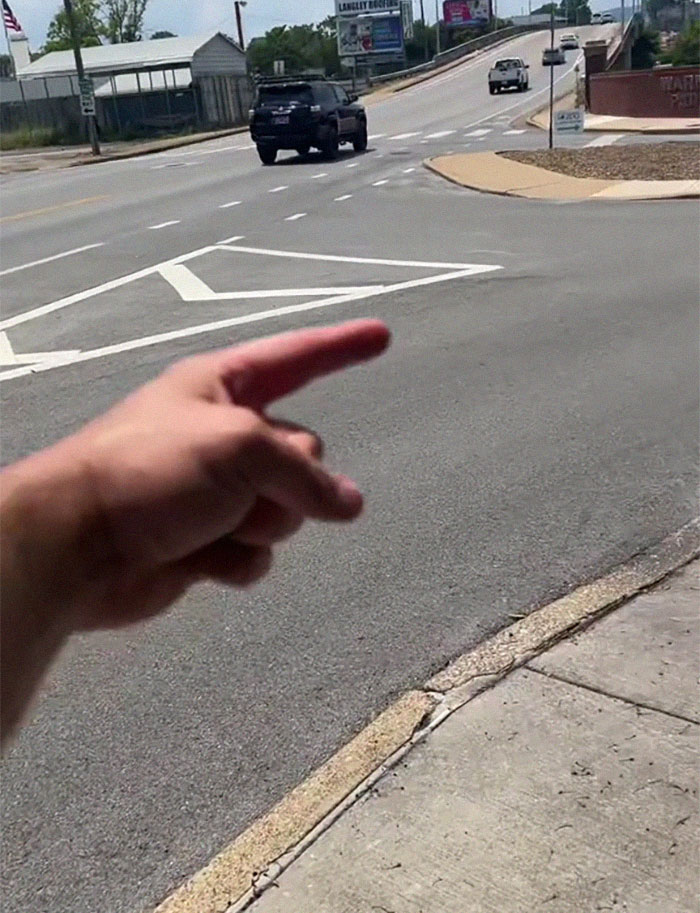
“These slip lanes are incredibly dangerous and it’s unnecessary in this situation. A car should just take a 90-degree turn right there.”

“I’m technically in the park, but I’m still not close to my destination. I’m going to walk through the grass just to take advantage of some of the shade.”
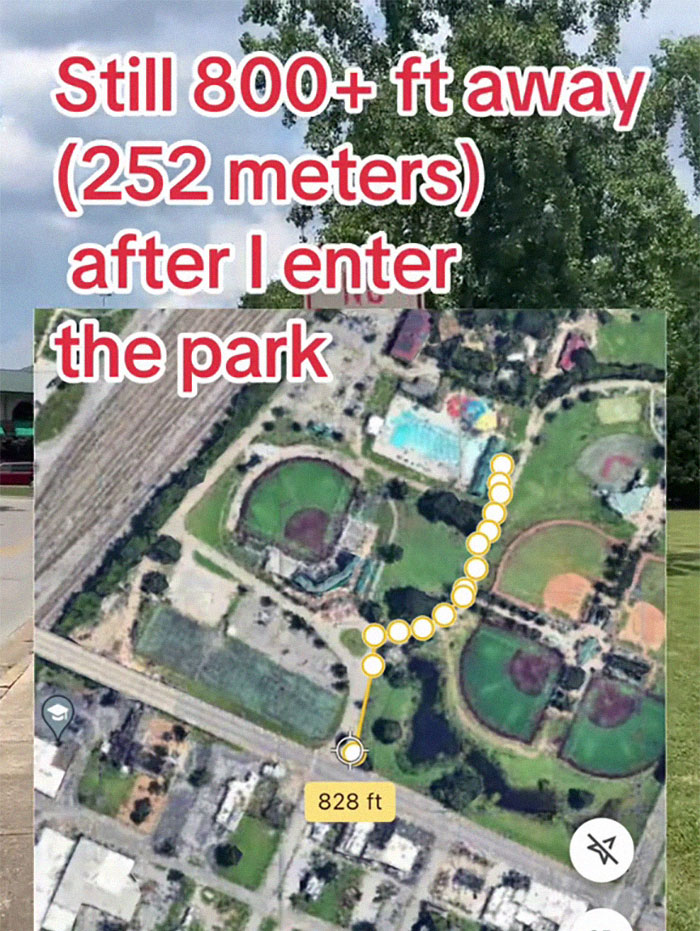
“Until we get local politicians and officials subjected to the walking conditions that many Americans are forced to experience, they won’t have built up enough empathy required for the political will it’s going to take to change this situation. Okay, I made it.”

You can watch Jon Jon’s entire journey to the park right here
“Walkability is all about increasing personal autonomy at the smallest possible level; it truly should be seen as an American ideal to increase the freedoms of everyone”
To find out how this conversation started in the first place, we reached out to Jon Jon Wesolowski, an Urbanist and speaker who lives in Chattanooga, Tennessee. “I spent seven and a half months in Europe last year. I was enamored with how simple it is to create delightful neighborhoods,” Jon Jon shared. “The more I delve into our built environment and its problems, the more I realize that we are choosing this through our policies. It doesn’t have to be this way, and I want to show people another way.”
As far as why it’s so important for Americans to address this issue, the urbanist says, “Walkability is all about increasing personal autonomy at the smallest possible level. It truly should be seen as an American ideal to increase the freedoms of everyone. We all start and end every trip we take as pedestrians; if we make it better for people walking, we make it better for everyone.”
Jon Jon also shared what changes he would like to see. “We need to allow for thoughtful mixed-use development; allow people to live within walkable distances to everyday needs like shops, parks, plazas, and other businesses, as is common in traditional cities. We need to de-prioritize traffic flow in cities,” he told Bored Panda.
“Cars are dangerous at speed. Downtowns thrive in part because people spend time there. It doesn’t make sense to create wider, speeding roads in places where we want people to linger. Lastly, we need safe and accessible infrastructure to make it easier for pedestrians and cyclists to get around,” Jon Jon added.
Finally, when it comes to what we can do, the urbanist recommends getting in touch with your local city councilors. “Take them to coffee. Ask them about local zoning laws and their stance on these issues. They are more available than you think, and even if you don’t feel like an expert, you can learn alongside each other,” Jon Jon shared.
And if you’d like to learn more from Jon Jon, be sure to visit his websiteThe Happy Urbanist. He’s also available to speak to organizations or cities about creating walkable communities, and you can follow him onInstagram,TikTok, andSubstack.
“Wealthier members of society presided over the redesign of our cites around the needs of their personal commutes, not considering the impact that optimizing their own driving would have”
To gain more insight into this topic, we reached out tocity planner,author, and international advocate for more walkable cities,Jeff Speck. Jeff was kind enough to have a chat withBored Pandaand explain why the vast majority of cities in the United States are not pedestrian-friendly.
“At a certain point in the second half of the 20th Century, the leadership in most American cities began to assume, without much consideration, that the automobile would become the way that everyone would get around, whether or not they could afford it,” Jeff shared.
“The car was transformed from an instrument of freedom into a prosthetic device that we would all need just to live our lives, as more and more of the built environment was reshaped around moving as much traffic as possible as quickly as possible,” the expert continued. “Roads were widened, sidewalks narrowed, trees chopped down, and transit defunded.”
“Just as significantly, land uses were dispersed along a highway system, federally subsidized, that made all other means of transportation deeply inefficient. In what has been called ‘elite projection,’ the wealthier members of society presided over the redesign of our cities around the needs of their personal commutes, not considering the impact that optimizing their own driving would have on the rest of the population,” Jeff noted.
“Many urban sidewalks are in the ‘crash zone’ of adjacent roads, which is certainly not safe for walkers”
We were also lucky enough to get in touch with Cameron Roberts, PhD, research fellow atProject Drawdown, the world’s leading resource for climate solutions. When it comes to why so many American cities are unwalkable, Dr. Roberts says there are many factors at play.
First, for a city to bewalkable, it must actually be traversable and compact, “meaning that distances are short enough that it takes a reasonable amount of time to get across them at normal walking speed,” Dr. Roberts says. “This is what people mean when they talk about fifteen-minute cities.”
Safety is another important factor to consider. “Many urban sidewalks are in the ‘crash zone’ of adjacent roads, which is certainly not safe for walkers,” Dr. Roberts explains. “There’s also the question of adequate shade in the summer and snow and ice clearance in the winter.”
“Finally, walkable environments should be physically enticing,” the expert continued. “That means that they should be pleasant to walk through, and have enough signage to be easy to navigate.”
“Interstate highways with few pedestrian overpasses, multi-lane roads, suburban cul-de-sacs rather than simple street grids, and big closed properties with only one way in so that people have to go all the way around to exit all reduce traversability,” Dr. Roberts says.
“The common thread here is that all of these things come from urban environments and city policies that prioritize cars,” Dr. Roberts added.
“People in walkable communities are considerably healthier, more social, more economically productive, and less destructive to the environment”
We also asked the experts about some of the benefits that come from living in a walkable city. “Studies show very clearly (and correcting for income discrepancy) that people in walkable communities are considerablyhealthier, more social, more economically productive, and less destructive to the environment,” Jeff told Bored Panda. “They are even less likely to be divorced!”
Jeff has actually gone into great detail explaining the many benefits walking provides inWalkable City, the best-selling urban planning book written this century.
Dr. Roberts encourages us to think about our vacations when we consider the benefits of walking. “Think about the places where people most often go on vacations. Disneyworld, an all-inclusive resort, a cruise ship, Manhattan, and Paris are all very different places, but what they have in common is that they are all places where you don’t have to drive very much, if at all,” he shared.
“Most people instinctively realize, at least on some level, that walkable places are pleasant and sociable places to be. Walking provides mild exercise, increases your chances of encountering a friend or having a nice conversation with a stranger, makes it easier to drop into a shop on a whim, and allows you to enjoy the fresh air,” he explained. “For many people, it’s also a welcome relief from the stress of driving.”
“Any workable solution to climate change has to involve getting people out of their cars and onto alternative forms of transportation”
And we can’t forget the environmental benefits. “Cars account for a major percentage of greenhouse gas emissions, and even electric vehicles produce significant greenhouse gas emissions per mile driven,” Dr. Roberts says.
The expert pointed out that walkability is also important for people who are not able to drive or use other forms of transportation. “Children or elderly people who live in walkable communities are more free to move around without needing to be chauffeured. The same goes for people with many types of disabilities that preclude them from driving,” he noted.
And of course, it’s great for ourhealth. “Physical activity is one of the most important determinants of overall health, and walking as a form of transportation is an easy way to fit physical mobility into a busy schedule,” Dr. Roberts says.
“Lose the car, look for a smaller apartment, and you might find that the walkable lifestyle is more affordable than you imagine”
Thankfully, Jeff says there are steps residents can take to push their cities towards becoming more walkable. “They can show up at public meetings and demand safer streets and bike lanes,” he shared. “They can attend hearings in support of projects that bring more housing into walkable, mixed-use areas.”
“They can participate in the public movements to eliminate single-family zoning and on-site parking requirements (see the YIMBY movement and the Parking Reform Network.) They can become Tactical Urbanists and restripe their streets to lower-speed geometries,” the expert continued. “Lay down a missing crosswalk with house paint when nobody is watching! Oops, did I just say that?”
“Finally, I would encourage people stuck in unwalkable suburbia to move,” Jeff added. “Lose the car, look for a smaller apartment, and you might find that the walkable lifestyle is more affordable than you imagine.” And if you’d like to learn more from Jeff about this topic, be sure to check outWalkable Cityor listen to any of hisTED talks!
“The more people can be seen walking outside, the more local politicians will pay attention to their needs”
As far as what we can do to create more walkable cities, Dr. Roberts says local political advocacy is probably the best way to take action. “It’s usually relatively uncontroversial to fix an unsafe crosswalk or intersection, although advocates might run up against entrenched resistance from traffic engineers and other local bureaucrats stuck in old ways of thinking,” he noted. “In this case, it could help to join forces with advocates for other forms of non-motorized mobility, such as cyclists or transit users.”“There are things that can be done at a grassroots level to improve the walkability of certain areas. Organizing to clean trash off a sidewalk could make it seem more inviting,” the expert continued. “And for kids to walk to school, some places have had success with ‘walking buses,’ a supervised group of kids who make stops at different houses to pick up more kids and walk together to school.”“For those who can or must, the simple act of using the walkable spaces that do exist, despite their shortcomings, can make others feel more comfortable using them,” Dr. Roberts added. “There’s safety in numbers. The more people can be seen walking outside, the more local politicians will pay attention to their needs.”Finally, the expert noted that humans are bipedal apes. “Walking is in our DNA. It is the least radical thing in the world. It only seems difficult in some places as the result of centuries of policy and infrastructural choices that have prioritized the interests of motorists over those of everyone else,” he explained.“We’re now starting to see the consequences of those choices not just for our cities but for the entire planet,” Dr. Roberts says. “The time has never been better to go back to more human-scale cities.”
As far as what we can do to create more walkable cities, Dr. Roberts says local political advocacy is probably the best way to take action. “It’s usually relatively uncontroversial to fix an unsafe crosswalk or intersection, although advocates might run up against entrenched resistance from traffic engineers and other local bureaucrats stuck in old ways of thinking,” he noted. “In this case, it could help to join forces with advocates for other forms of non-motorized mobility, such as cyclists or transit users.”
“There are things that can be done at a grassroots level to improve the walkability of certain areas. Organizing to clean trash off a sidewalk could make it seem more inviting,” the expert continued. “And for kids to walk to school, some places have had success with ‘walking buses,’ a supervised group of kids who make stops at different houses to pick up more kids and walk together to school.”
“For those who can or must, the simple act of using the walkable spaces that do exist, despite their shortcomings, can make others feel more comfortable using them,” Dr. Roberts added. “There’s safety in numbers. The more people can be seen walking outside, the more local politicians will pay attention to their needs.”
Finally, the expert noted that humans are bipedal apes. “Walking is in our DNA. It is the least radical thing in the world. It only seems difficult in some places as the result of centuries of policy and infrastructural choices that have prioritized the interests of motorists over those of everyone else,” he explained.
“We’re now starting to see the consequences of those choices not just for our cities but for the entire planet,” Dr. Roberts says. “The time has never been better to go back to more human-scale cities.”
Readers called out the unfortunate conditions and echoed the importance of having walkable cities







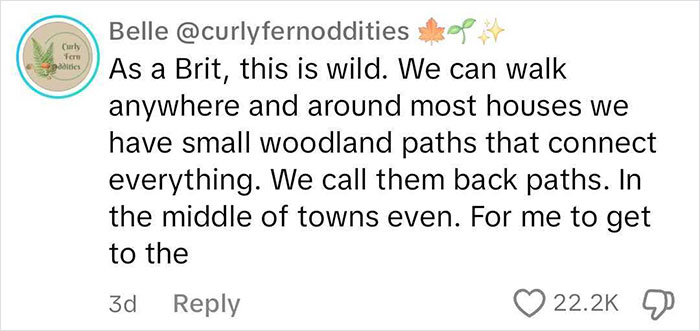
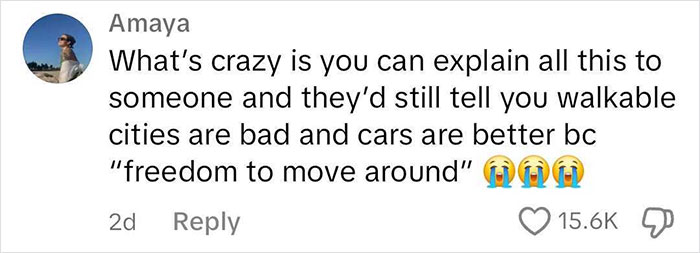
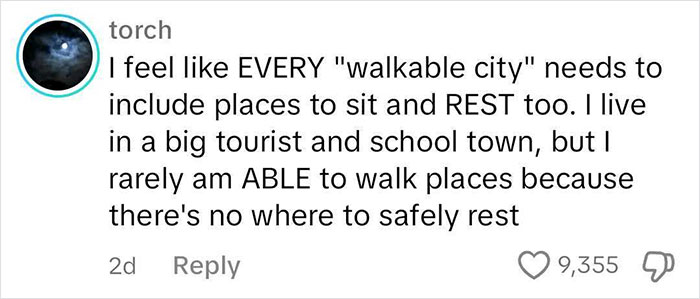

Thanks! Check out the results:
Social Issues